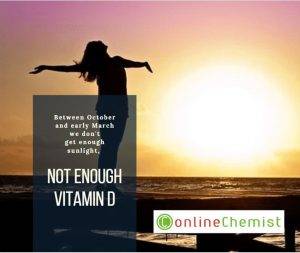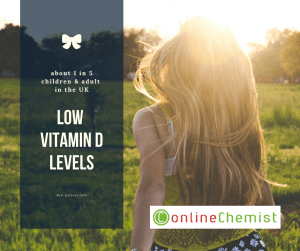Follow us
Online Chemist is a trading name of Nomaz Limited, Registered in England, 11349276. © All rights reserved.
Vitamin D is essential for our health and well-being. Vitamin D is mostly made in the skin by exposure to sunlight.
Between October and early March we don’t get enough sunlight, hence not enough Vitamin D.
A lack of vitamin D can lead to bone deformities such as rickets in children, and bone pain caused by a condition called osteomalacia in adults.

Bones can feel painful to moderate pressure. Bone pain often also occurs in the lower back, hips, pelvis, thighs and feet.
Muscle weakness may cause difficulty in climbing stairs or getting up from the floor or a low chair, or can lead to the person walking with a waddling pattern.
Muscle pain
Fatigue and tiredness
Depression
Impaired wound healing
Hair loss
Greater risk of developing conditions such as diabetes, heart diseases, certain cancers and possibly weight gain.
Not exposed to much sunlight, for example, if you:
• Are housebound
• Stay indoors for long periods, such as if in a hospital or working indoors much of the day
• Cover up your skin for cultural or other reasons.
People who have darker skin, which will naturally reduce the amount of sunlight reaching the skin
Men and women aged 65 years and above as older skin may not make as much vitamin D
Pregnant or breast feeding women, especially teenagers and young women
Children under 5 years of age
Some medical conditions can affect the way the body handles vitamin D. People with Crohn’s disease, coeliac disease, and some types of liver and kidney disease, are all at risk of vitamin D deficiency
Vitamin D deficiency can also occur in people taking certain medicines. Examples include: carbamazepine, phenytoin, primidone, barbiturates and some anti-HIV medicines

In the UK, it’s now recommended that everyone aged 1 year or over should be getting at least 10 micrograms (400 IU) a day of vitamin D.
In the UK, sunlight is only bright enough to make useful amounts of vitamin D from April to October and between 11am to 3pm
Vitamin D can be found in some foods, but is usually only present in small amounts, so dietary sources are unlikely to provide enough.
Some vitamin D can be found in oily fish (such as kippers, sardines, mackerel, trout and salmon), meat and eggs.
A few foods have vitamin D added to them, such as some margarine and low fat spreads, some breakfast cereals, powdered milks, dairy and soya products.
In the UK, cows’ milk is generally not a good source of vitamin D because it isn’t fortified, as it is in some other countries.
If you are in an at-risk group, a daily dose of 10 to 25 micrograms (400 – 1000IU) vitamin D is recommended, unless your doctor advises otherwise.
It is important that you are not already taking vitamin D in another product, such as a multi-vitamin, combination with calcium, cod liver oil – so always check labels carefully. Speak to your pharmacist if not sure.
You can buy vitamin D supplements from from the pharmacy, supermarkets or health food shops.

Online Chemist
82 Middleton Road
Gorleston
Great Yarmouth
Norfolk
NR31 7AH
Phone: 01493 600610
Mobile: 07852317538
Email: onchemuk@gmail.com
Click here for driving directions
Online Chemist is a trading name of Nomaz Limited, Registered in England, 11349276. © All rights reserved.
Superintendent Pharmacist: Obaidullah Zaman; Superintendent GPhC Reg. Number: 2083409; Pharmacy Premises GPhC Reg. Number: 9011159
Don’t simply rely on our claims, become part of the delighted community of thousands of customers who are experiencing the remarkable benefits!

Online Chemist
82 Middleton Road
Gorleston
Great Yarmouth
Norfolk, NR31 7AH
Phone: 01493 600610
Email: info@onlinechemistuk.net
Superintendent Pharmacist:
Obaidullah Zaman
BPharm, MPharm, PGDip (Pharmacy), MRPharmS, IP
GPhC Reg. Number: 2083409
Pharmacy Premises GPhC Reg. Number: 9011159
Monday 09:00 – 17:00
Tuesday 09:00 – 17:00
Wednesday 09:00 – 17:00
Thursday 09:00 – 17:00
Friday 09:00 – 17:00
Saturday Closed
Sunday Closed
Click here for driving directions
OnlineChemist is a trading name of Nomaz Limited.
Registered in England – 11349276.
© 2025 All rights reserved.